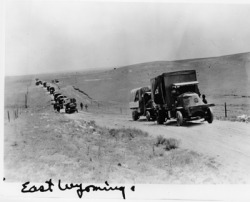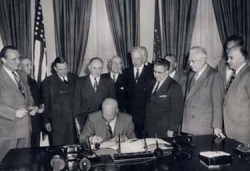Introduction
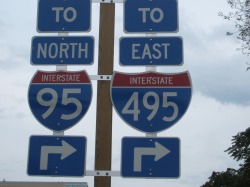
By Christopher Crunkleton
The Interstate Highway System, formally known as the Dwight D. Eisenhower National System of Interstate and Defense Highways, is a network of roads that connects almost every major city in the United States. The system is an important part of our daily lives, yet many people take it for granted. Each year, people travel almost a trillion miles on the Interstate System.
Click on the arrow below for comments by Richard Weingroff, Historian of the Federal Highway Administration.
The Interstates owe their existence mainly to the vision of President Dwight D. Eisenhower. As a young soldier in 1919, Eisenhower traveled across country in a convoy and realized how dangerous and slow it was to travel our national roads.
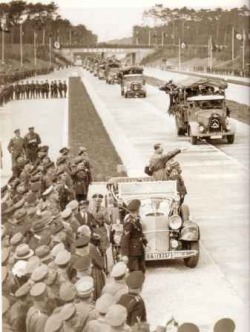
Hitler salutes military troops on Autobahn. Source: German-Architecture.Info.
Later, during World War II, Eisenhower saw the German military use its Autobahn to easily transport supplies and troops.
These two experiences convinced him to advocate for safer and more efficient roads in the U.S. He told Congress:
Legislation to provide a modern, interstate highway system is even more urgent this year than last, for 12 months have now passed in which we have fallen further behind in road construction needed for the personal safety, the general prosperity, the national security of the American people. During the year, the number of motor vehicles has increased from 58 to 61 million. During the past year over 38,000 persons lost their lives in highway accidents, while the fearful toll of injuries and property damage has gone on unabated.
In my message of February 22, 1955, I urged that measures be taken to complete the vital 40,000 mile interstate system over a period of 10 years at an estimated Federal cost of approximately 25 billion dollars. No program was adopted.
If we are ever to solve our mounting traffic problem, the whole interstate system must be authorized as one project, to be completed approximately within the specified time. Only in this way can industry efficiently gear itself to the job ahead. Only in this way can the required planning and engineering be accomplished without the confusion and waste unavoidable in a piecemeal approach. Furthermore, as I pointed out last year, the pressing nature of this problem must not lead us to solutions outside the bounds of sound fiscal management. As in the case of other pressing problems, there must be an adequate plan of financing. To continue the drastically needed improvement in other national highway systems, I recommend the continuation of the Federal Aid HighwayProgram.
Eisenhower State of Union address, 1956.
President Eisenhower signs H.R. 8127, an act "to amend and supplement the Federal-Aid Road Act approved July 11, 1916 . . . to authorize appropriations for continuing the construction of highways . . ." L-R: Sen. Styles Bridges; Rep. George Dondero; Rep. Clifford Davis; Sen. Francis Case; Rep. Homer Angell; Sen. Edward Martin; unidentified; Rep. J. Harry McGregor; unidentified; Sen. William Knowland; Sen. Prescott Bush; unidentified. May 6, 1954. Source: Dwight D. Eisenhower Presidential Library and Museum.
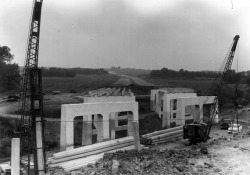
Construction of Highway in Iowa, 1958. Source: Iowa Public Television (iptv.org)
The nation’s largest public construction project began in 1956 with passage of the National Interstate and Defense Highways Act. It was completed forty years later in Boston in 1996 at a total cost of over $140 billion. Today it consists of over 45,000 miles of road stretching from the Atlantic to the Pacific and from Canada to Mexico. In theory, motorists can travel from coast to coast without stopping at a single traffic light. Astronauts can see the System from space. The concrete used to build the Interstate could make a wall nine feet thick, fifty feet tall, all the way around the world.
The Interstate has had an enormous impact on local and national economies as well as Americans' quality of life. In fact, it is difficult to quantify all the ways that the Interstate has affected our lives. Perhaps that is why today many Americans feel indifferent towards it.
The Interstate has had an enormous impact on local and national economies as well as Americans' quality of life. In fact, it is difficult to quantify all the ways that the Interstate has affected our lives. Perhaps that is why today many Americans feel indifferent towards it.
